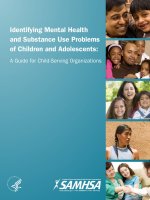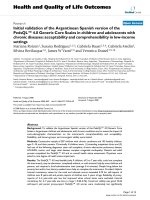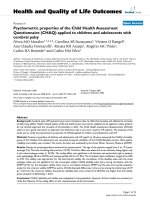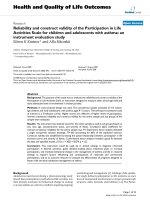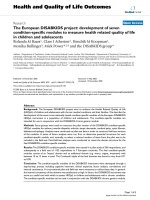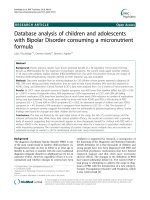Health-related quality of life of children and adolescents with osteogenesis imperfecta: A cross-sectional study using PedsQL™
Bạn đang xem bản rút gọn của tài liệu. Xem và tải ngay bản đầy đủ của tài liệu tại đây (365.14 KB, 6 trang )
Vanz et al. BMC Pediatrics (2018) 18:95
/>
RESEARCH ARTICLE
Open Access
Health-related quality of life of children and
adolescents with osteogenesis imperfecta:
a cross-sectional study using PedsQL™
Ana Paula Vanz1, Juliana van de Sande Lee2,3, Bruna Pinheiro1, Marina Zambrano1, Evelise Brizola1,
Neusa Sicca da Rocha4, Ida Vanessa D. Schwartz5,6,7,8, Maria Marlene de Souza Pires2,3 and Têmis Maria Félix1,8*
Abstract
Background: Osteogenesis imperfecta (OI) is a disorder of bone formation leading to low mineral density and
fractures. Children and adolescents with OI require periodic medical follow up, corrective surgery, drug therapy and
physical therapy, as well as specific daily care practices. In addition, they have an increased incidence of fractures,
which require immobilization and cause severe discomfort and short-term disability. This study evaluated the
health-related quality of life of children and adolescents with OI in two reference centers for OI treatment in
southern Brazil.
Methods: In this prospective cross-sectional study, the Pediatric Quality of Life Inventory (PedsQLTM) was applied in
two university-affiliated reference centers for OI treatment in southern Brazil. Children and adolescents aged ≥ 5
years with clinical diagnoses of OI were included. Clinical data and socioeconomic status was evaluated.
Results: The sample consisted of 52 children and adolescents with OI (aged 5-17 years); 26 (50%) participants with
type I OI, 13 (25%) type IV, 12 (23.1 %) type III, and 1 (1.9%) type V OI. Physical and social functioning domains
differed significantly according to clinical presentation of OI with lowest scores in the severe type (OI type III). Pain
seems to be the variable that is most associated with impact on the PedsQL domains.
Conclusions: Overall, this study revealed differences in physical functioning and social functioning in relation to OI
clinical presentation. These results reinforcing the importance of the clinical management of these patients with the
aim of functional improvement and importance of pain control.
Keywords: Osteogenesis imperfecta, Quality of life, Sickness impact profile, Child, Adolescent
Background
Osteogenesis imperfecta (OI) is a disorder of bone formation leading to low mineral density and fractures [1, 2].
The incidence of OI is approximately 1/10,000-20,000
births [1]. It is usually caused by pathogenic mutations in
the genes involved in the production of type I collagen,
the main building block of bone, leading to reduced collagen production or structural failure. Approximately 8090% of mutations occur in the COLIA1 and COLIA2
genes, which encode the α1 and α2 subunits of type I
* Correspondence:
1
Child and Adolescent Health, Universidade Federal do Rio Grande do Sul,
Porto Alegre, Brazil
8
Medical Genetics Service, Hospital de Clinicas de Porto Alegre, Porto Alegre,
Brazil
Full list of author information is available at the end of the article
collagen, respectively [3]. Recently, several molecular
studies identified additional genes involved in the biosynthesis of collagen as causing OI. However, the
classification of OI that remains in widespread use is
based on clinical and radiological features and defines
five distinct types (I-V) [4, 5].
Many individuals with genetic disorders struggle with
a variety of conditions that accompany chronic disease.
Individuals with OI require periodic medical follow up,
corrective surgery, drug therapy and physiotherapy, as
well as specific daily care practices. In addition, they
have an increased incidence of fractures, seen more frequently in children and adolescents, which require
immobilization and cause severe discomfort and shortterm disability [6]. Thus, OI is assumed to have a major
© The Author(s). 2018 Open Access This article is distributed under the terms of the Creative Commons Attribution 4.0
International License ( which permits unrestricted use, distribution, and
reproduction in any medium, provided you give appropriate credit to the original author(s) and the source, provide a link to
the Creative Commons license, and indicate if changes were made. The Creative Commons Public Domain Dedication waiver
( applies to the data made available in this article, unless otherwise stated.
Vanz et al. BMC Pediatrics (2018) 18:95
impact on patients’ quality of life (QoL). Measurement
and analysis of health-related quality of life (HRQoL) in
individuals with genetic disorders, particularly OI, are
essential for the evaluation not only of treatment outcomes, but also of patients’ well-being. This intervention
may facilitate the work of professionals by modifying
factors that go beyond health outcomes, including environmental, psychosocial, and school-related aspects,
which may affect patients’ QoL. This study aimed to assess and characterize the HRQoL of children and adolescents with different types of OI.
Methods
Participants in this prospective cross-sectional study
were recruited by convenience sampling between
December 2013 and January 2015 at two universityaffiliated reference centers for OI treatment in two
southern Brazilian states: the Clinical Hospital of Porto
Alegre in Porto Alegre and Joana Gusmão Hospital in
Florianópolis. The study was approved by the research
ethics committees of both institutions and was conducted in accordance with the provisions of the Declaration of Helsinki. All parents or guardians provided
written informed consent prior to patients’ inclusion in
the study.
Children and adolescents were invited to participate
after routine outpatient visits. No patient presenting for
a first visit to the hospital was included in the study.
The sample included children and adolescents aged ≥ 5
years with clinical diagnoses of OI type I, III, IV, or V.
The OI classification adopted in this study was based on
the clinical criteria established by Van Dijk and Sillence
[5]. Patients diagnosed with and/or treated for anxiety
and depression were excluded from the study.
Participants’ socioeconomic status was assessed using
a validated Brazilian questionnaire based on the Brazilian
Association of Research Companies Economic Classification Criterion [7]. This questionnaire yields a score
that can be used to stratify the population into socioeconomic status ranges (A1, A2, B1, B2, C1, C2, D, and E),
with “A” corresponding to the highest score and “E” to
the lowest score [7].
Bleck’s criteria [8], modified by Land et al [9], were
used to evaluate mobility: (0) not walking, (1) therapeutic walking, (2) household walking with or without
assistance, (3) neighborhood or community walking with
or without assistance, and (4) independently walking.
For statistical calculations, classifications of 0, 1, and 2
were grouped and compared with classifications of 3 and
4. Two researchers (JVL and APV) collected clinical
data.
Given the wide range of patient age at the time of
evaluation, we calculated the rate of fracture according
to the number of fractures/year. Patients were also asked
Page 2 of 6
whether they remembered having felt pain in the last
month. Bisphosphonate treatment was investigated in
patients receiving intravenous pamidronate (which is
usually indicated for the more severe forms of OI with
bone quality compromise), alendronate, or no
medication.
HRQoL was evaluated using the Pediatric Quality of
Life Inventory (PedsQL™ 4.0 Generic Core), a generic assessment instrument that has been validated in Brazilian
Portuguese [10]. This self-report instrument consists of
23 items in four domains: physical functioning (8 items),
emotional functioning (5 items), social functioning (5
items), and school functioning (5 items). Responses are
used to calculate total, psychosocial health, and physical
summary scores. Scores were summarized according to
a statistical model established by the authors of PedsQL™
4.0 [11–16]. They were expressed as transformed scores
on a 0-100 scale, with higher scores indicating better
QoL. Children and adolescents filled out this self-report
questionnaire. For children aged 5 to 7 years all questions were read by the researchers and answers were
given according to a visual analogic scale as suggested
by PedsQL™.
Continuous data were described by mean and
standard deviation. Categorical data were presented as
counts and percentages. Asymmetrical distribution
variables were described by median, interquartile
range, and range. Since the PedsQL score followed a
nearly symmetrical distribution, mean groups of OI
clinical presentation were compared using analysis of
variance (ANOVA) with robust standard errors approach when required. Accordingly, the Tukey's and
Dunnet's T3 (robust) tests were used for post hoc
comparisons. Correlations between continuous symmetrical variables were computed using Pearson's
product moment correlation coefficient or Spearman's
rank correlation coefficient (rho) for situations where
ordinal or not asymmetrical distributed variables we
involved. A multiple linear regression model was used
to simultaneously evaluate the impact of mobility,
medical treatment, annual fracture rate, and pain
score on the total PedsQL score and all the other
component domains. The selection of these variables
was more based on the underlying conceptual framework found in the specialized literature rather than
on pure statistical significance. Asymmetrically distributed variables were log transformed before inclusion
in the model. The standardized beta coefficient was
used to asses and compare the magnitude of association of these factors with the different PedsQL domains in the multiple linear regression model.
Statistical significance was set at p<0.05. Data were
processed and analyzed using R version 3.3.0 and
SPSS version 22.0.
Vanz et al. BMC Pediatrics (2018) 18:95
Page 3 of 6
Results
The sample was composed of 52 children and adolescents with OI: 12 (23.1%) from the Florianopolis center
and 40 (76.9%) from the Porto Alegre center. Patient
characteristics are summarized in Table 1. Twenty-six
(50%) participants had type I OI, 12 (23.1%) had type III,
13 (25%) had type IV, and one (1.9%) participant had
type V OI. Twenty-five (48.1%) patients used pamidronate and one (1.9%) used alendronate; 19 (36.5%)
Table 1 Characteristics of study participants
Variable n= 52
Frequency no. (%)
Male
29 (55.7)
Age (years)
5-7
13 (25.0)
8-12
24 (46.2)
13-18
15 (28.8)
Mean (SD)
11.2 ± 4.2
OI type
I
26 (50.0)
III
12 (23.1)
IV
13 (25.0)
V
1 (1.9)
Treatment
Sodium pamidronate
25 (48.1)
Sodium alendronate
01 (01.9)
Physiotherapy
19 (36.5)
a
Mobility
Wheelchair
13 (25.0)
Walk or walk with support
38 (73.0)
Pain in the last month (n=44)
Yes
19 (43.2)
No
25 (56.8)
b
Annual fracture rate
Median (IQR)
0.91 (0.47 to 1.67)
Minimum to Maximum
0.06 to 6.33
Social assistance (n=42)
Yes
20 (47.6)
No
22 (52.4)
Socioeconomic status (n=47)
a
A
1 (2.1)
B1
3 (6.4)
B2
13 (27.7)
C1
13 (27.7)
C2
9(19.1)
D-E
8 (17.0)
Bleck’s criteria [8], modified by Land et al [9], were used to evaluate mobility
walking. For statistical calculations, classifications of 0, 1, and 2 were grouped
and compared with classifications of 3 and 4. bNumber of fractures/year.
patients were in physiotherapy. Thirteen (25%) patients
used a wheelchair and 38 (73.01%) walked with support
or independently. One patient was not included in the
sample because he had a diagnosis of hyperactivity.
Thirty-seven (71.2%) children and 15 (28.8%) adolescents completed the PedsQLTM. In the total sample,
mean physical functioning scores were lowest and mean
social functioning scores were highest. In the analysis of
mean domain scores according to clinical presentation,
the physical functioning and social functioning scores
differed significantly between participants with mild,
moderate and severe forms of OI (Table 2).
Clinical presentation was moderately correlated with
physical functioning domain (rho = -0.38, p = 0.006) and
socioeconomic status was inversely correlated with
school functioning domain (rho = -0.31, p = 0.036). Age
presented a weak correlation with the social functioning
domain score, although significant (r = 0.29, p = 0.037).
The annual fracture rate showed no significant correlation with any domain score.
Multiple linear regression analysis showed that pain
score was statistically associated with all PedsQL domains except schooling. The pain score presented higher
magnitudes of association with the total score, followed
by psychosocial health, emotional, social, and physical
functioning (Table 3).
Discussion
This study examined self-reported HRQoL of children
and adolescents with OI using measures applicable to
the age range investigated. Curiously, QoL is not frequently assessed in individuals with genetic disorders. A
systematic review published in 2010 [17] identified 58
studies in which QoL was assessed using validated questionnaires in patients with genetic conditions. Only one
of these studies examined patients with OI; QoL was
assessed in an adult cohort using the SF-36, a validated
health self-assessment questionnaire [18]. In a recently
published scoping review that addressed the impacts of
three genetic musculoskeletal diseases, 15 papers addressing OI were identified, but none focused on children and adolescents or assessed HRQoL with an
available and validated inventory [19]. All articles used
the term QoL, but the studies evaluated only physical
factors such as functionality, and none used a tool designed to measure the QoL construct in children and
adolescents.
Parents were formerly believed to be the appropriate
informants about their children’s HRQoL. The current
perspective is that children are able to speak for themselves, enabling researchers to avoid relying solely on
parents’ opinions, which are influenced by their own experience and backgrounds [20–22]. Children and adolescents with chronic diseases requiring regular healthcare
Vanz et al. BMC Pediatrics (2018) 18:95
Page 4 of 6
Table 2 PedsQLTM scores according to OI Clinical Presentation
PedsQLTM score
Total
Total sample
Clinical presentation*
Mild
Moderate
Severe
n = 52
n = 26
n = 14
n=12
69.7 ± 13.1
71.3 ± 12.4
71.0 ± 13.2
a
a
p**
64.8 ± 14.8
b
0.349
Physical functioning
61.9 ± 21.1
69.2 ± 17.2
58.5 ± 23.7
50.0 ± 14.8
0.023
Psychosocial health
72.3 ± 12.7
71.9 ± 12.0
75.1 ± 11.7
69.7± 15.7
0.558
Emotional Functioning
66.3 ± 18.1
65.9 ± 16.3
67.0 ± 18.4
66.2 ± 22.9
0.984
Social functioning
77.7 ± 16.3
76.1 ± 19.3a,b
85.7 ± 8.0a
71.6 ±13.3b
0.007
School functioning
73.2 ± 15.2
74.5 ± 10.9
72.6 ± 17.8
71.2 ± 20.2
0.829
Data are presented as means ± standard deviations. *Clinical presentation- Mild (OI type I); Moderate (OI type IV and V); Severe (OI type III). **ANOVA, different
index letters represent statiscally significant difference at the post hoc test
acquire knowledge about their health and are able to express their needs related to the disease. Often, their
opinions about their health status are much more accurate than those of their parents or caregivers [23]. In this
study, for example, two children using wheelchairs
responded “never” to the item “It is hard for me to walk
more than one block”; that is, their perception of “walking” was appropriate.
As reported by Fano et al [24], we found that patients
with moderate and severe OI had lower physical functioning domain than did those with mild OI. This finding shows that the physical health component of QoL is
compromised in severely affected patients, making them
somewhat “uncomfortable.” In a qualitative study of children and adolescents with OI, physical health status was
associated with the following themes: being safe and
careful, reduced function, pain, fear, isolation, and independence [22]. In another study in which QoL related to
olpadronate use was evaluated using the Self-Perception
Profile for Children, the athletic performance score was
lowest [25]. In the assessment of HRQoL using
PedsQLTM in patients with Duchenne muscular dystrophy, the most common inherited pediatric neuromuscular disorder and a cause of significant physical
limitation, the physical domain score was lowest in children and adolescents [26].
Multiple linear regression analysis showed that pain affected total, physical functioning, emotional functioning,
and psychosocial health scores. In OI, bone fragility results in recurrent fractures, leading to bone pain. Bone
deformity also contributes to physical discomfort. A previous analysis of emergency department records demonstrated the need for additional effort and resources to
address the under treatment of pain in children and
adults with fractures in the emergency setting [27]. The
authors stated that special attention should be given to
analgesia for the very old and very young. They concluded that the education of providers on nonverbal options for measuring pain, especially in young children,
may improve the measurement and documentation of
pain status and facilitate recognition and treatment of
pain in these vulnerable populations [27].
Socioeconomic status was correlated negatively with
school functioning in the present sample, in which
26/52 (50%) patients’ family status was classified as
B2 or C1. The 2012 Brazilian Institute of Statistics
and Public Opinion survey showed that 29% of the
Brazilian population belongs to class C1, followed by
classes C2 (24%) and B2 (21%). Since 2005, improvement in the population’s economic status has been
observed [28, 29]. In contrast to the findings of the
present study, economic level was not correlated with
QoL scores in our previous study of caregivers of individuals with OI [30]. In another study conducted in
southern Brazil, socioeconomic level was correlated
positively with environmental and social domain
scores [31]. The differences can be explained by a
small sample size and asymmetric distribution of the
socioeconomic status in our study.
Age was positively correlated with the social functioning domain score in the present study. Although the literature does not contain reports of the impact of
fractures on the QoL of children and adolescents, fracture is an important modifier of physical condition. It
was one the six main themes identified in a qualitative
interview-based study involving children and adolescents
with OI, as well as their parents [22].
Seikaly et al [32], evaluated the impact of alendronate
therapy on QoL in children with OI; however, no specific instrument was used to measure QoL. Their study
focused on assessing individuals’ self-care and functional
ability through application of a visual analog scale for
pain and assessment of the number of days without pain.
They found significant improvement in subjective wellbeing, pain, and analgesia use scores in subjects treated
with alendronate. In the assessment of HRQoL using
PedsQLTM, Fano et al [24] also identified pharmacological treatment as a modifying factor in a linear
Vanz et al. BMC Pediatrics (2018) 18:95
Page 5 of 6
Table 3 The impacts of selected patient characteristics on
PedsQLTM scores, as determined by multiple linear regression
Standardized beta coefficient
p
Mobility
0.22
0.19
Medical treatment
0,28
0.19
Annual fracture rate
-0.28
0.12
Pain score
-0.37
0.009
Mobility
0.35
0.03
Medical treatment
0,08
0.67
Annual fracture rate
-0.27
0.34
Pain score
-0.27
0.05
Mobility
0.11
0.52
Medical treatment
0.33
0.12
Annual fracture rate
-0.23
0.20
Pain score
-0.36
0.012
PedsQLTM domain/characteristic
Total
Physical functioning
Psychosocial health
Emotional functioning
Mobility
0.10
0.56
Medical treatment
0.26
0.23
Annual fracture rate
-0.06
0.72
Pain score
-0.35
0.015
Mobility
0.62
0.72
Medical treatment
0.20
0.35
Annual fracture rate
-0.20
0.28
Pain score
-0.28
0.015
Social functioning
School functioning
Mobility
0.09
0.60
Medical treatment
0.27
0.23
Annual fracture rate
-0.27
0.17
Pain score
-0.20
0.18
Ninety-five percent confidence intervals were calculated and the level of
significance was set at p < 0.05.
regression analysis. The design of the present study did
not enable the comparison of treatment regimens; randomized studies are needed to characterize the main effects of drug therapy on OI patients' QoL.
This study has limitations. QoL is a construct with
multiple definitions and it is based on qualitative variables, therefore, assessment using generic instruments
that produce only quantitative variable values may have
limited the analysis in this study. We believe that QoL
can be assessed more accurately when quantitative and
qualitative tools are used in combination. Moreover, the
use of specific questionnaires is ideal for measurement
of the impact of chronic disease on QoL with greater accuracy and sensitivity. To date, no specific questionnaire
has been validated for patients with OI. Furthermore,
the small sample size and convenience sampling limited
the power this study. It should be noted that this is a
usual finding when studying rare diseases and efforts
were made to increase the sample size, recruiting subjects from different centers.
Conclusions
Most chronic illnesses should be seen as stressors that
may ultimately affect child development and can restrict
children’s school and social performance, even in the
family context. Estimation of the impact of chronic disease on the lives of children and adolescents is of fundamental importance for the development of interventions
that can compensate for these deficits.
The measurement of QoL is gaining momentum and
its consideration is having positive effects in health practice, as it allows the development and implementation of
comprehensive interventions, rather than focusing only
on the health/disease process. Overall, this study revealed differences in physical functioning in relation to
OI severity and mobility, reinforcing the importance of
the clinical management of these patients with the aim
of functional improvement. Further studies in the same
population with specific instruments for the measurement of QoL are required to support these results and
provide more representative data.
Abbreviations
CAAE: Certificado de Apresentação para Apreciação Ética; HRQoL: Healthrelated quality of life; OI: Osteogenesis imperfecta; PedsQLTM: Pediatric
Quality of Life Inventory; QoL: Quality of life
Acknowledgments
We thank the children and adolescents and their parents who participated in
this study and the Group for Research and Postgraduate Studies (Grupo de
Pesquisa e Pós-Graduação) for their assistance with the statistical analysis,
Fundação de Amparo à Pesquisa do Estado do Rio Grande do Sul (FAPERGS)
and Hospital de Clínicas de Porto Alegre (FIPE/HCPA). APV received a
scholarship from Coordenação de Aperfeiçoamento de Pessoal do Nível
Superior (CAPES). TMF is supported by CNPq #306245/2016-7.
Funding
Fundação de Amparo à Pesquisa do Estado do Rio Grande do Sul (FAPERGS)
and Hospital de Clínicas de Porto Alegre (FIPE/HCPA).
Availability of data and materials
The datasets used and/or analysed during the current study are available
from the corresponding author on reasonable request.
Author’s contributions
APV- planned the approach to the present paper, data collection, performed
the statistical analysis and drafted the manuscript. JVSL- planned the
approach to the present paper, data collection, analysis and interpretation of
results. BP, MZ, EB, NSR and MMSP- participated in analysis and interpretation
of results. TMF- participated in the design, data collection and coordination
of the study. All authors read and approved the final manuscript.
Vanz et al. BMC Pediatrics (2018) 18:95
Ethics approval and consent to participate
All procedures performed in studies involving human participants were in
accordance with the ethical standards of the institutional and/or national
research committee and with the 1964 Helsinki declaration and its later
amendments or comparable ethical standards. The study was approved by
the research ethics committees of both institutions and was conducted in
accordance with the provisions of the Declaration of Helsinki (Research
Ethics Committee at Hospital de Clínicas de Porto Alegre, CAAE:
19041613.7.0000.5327 and Research Ethics Committee at Joana Gusmão
Hospital, CAAE: 19041613.7.3001.536). All parents or guardians provided
written informed consent prior to patients’ inclusion in the study.
Consent for publication
Not applicable.
Competing interests
Not applicable.
Publisher’s Note
Springer Nature remains neutral with regard to jurisdictional claims in
published maps and institutional affiliations.
Author details
1
Child and Adolescent Health, Universidade Federal do Rio Grande do Sul,
Porto Alegre, Brazil. 2Division of Pediatric Endocrinology, Hospital Infantil
Joana de Gusmão, Florianópolis, Brazil. 3Medical Sciences, Universidade
Federal de Santa Catarina, Florianópolis, Brazil. 4Medical Sciences: Psychiatry,
Universidade Federal do Rio Grande do Sul, Porto Alegre, Brazil. 5Medical
Sciences, Universidade Federal do Rio Grande do Sul, Porto Alegre, Brazil.
6
Department of Genetics, Universidade Federal do Rio Grande do Sul, Porto
Alegre, Brazil. 7Health Technology Assessment in Clinical Genetics Research
Group, Hospital de Clínicas de Porto Alegre, Porto Alegre, Brazil. 8Medical
Genetics Service, Hospital de Clinicas de Porto Alegre, Porto Alegre, Brazil.
Received: 3 February 2016 Accepted: 20 February 2018
References
1. Cole WG. Advances in Osteogenesis Imperfecta. Clin Orthop Relat Res. 2002;
401:6–16.
2. Rauch F, Glorieux FH. Osteogenesis Imperfecta. Lancet. 2004;363:1377–85.
3. Byers PH, Wallis GA, Willing MC. Osteogenesis imperfecta: translation of
mutation to phenotype. J Med Genet. 1991;28(7):433–42.
4. Osteogenesis Imperfecta Foundation. Facts about Osteogenesis Imperfecta.
[update 2015 Jun 16 cited 2015 Jun 16] Available from .
5. Van Dijk FS, Sillence DO. Osteogenesis imperfecta: clinical diagnosis,
nomenclature and severity assessment. Am J Med Genet A. 2014;164A(6):
1470–1.
6. Engelbert RH, Uiterwaal CS, Gulmans VA, Pruijs H, Helders PJ. Osteogenesis
imperfecta in childhood: prognosis for walking. J Pediatr. 2000;137:397–402.
7. Brasil (2012). ABEP-Associação Brasileira de Empresas de Pesquisa. Critérios
de Classificação Econômica Brasil, 2012. [update 2014 Dec 10 cited 2015 Jun
16]. Available from www.abep.org.
8. Bleck EE. Nonoperative treatment of osteogenesis imperfecta: orthotic and
mobility management. Clin Orthop Relat Res. 1981;(159):111–22.
9. Land C, Rauch F, Montpetit K, Ruck-Gibis J, Glorieux FH. Effect of
intravenous pamidronate therapy on functional abilities and level of
ambulation in children with osteogenesis imperfecta. J Pediatr. 2006;148:
456–60.
10. Klatchoian DA, Len CA, Terreri MTRA, Silva M, Itamoto C, Ciconelli RM, et al.
Quality of life of children and adolescents from São Paulo: reliability and
validity of the Brazilian version of the Pediatric Quality of Life InventoryTM
version 4.0 Generic Core Scales. J Pediatr (Rio J). 2008; Aug;84(4):308–15.
11. Varni JW, Seid M, Kurtin PS. The PedsQL™ 4.0: Reliability and validity of the
Pediatric Quality of Life Inventory™ Version 4.0 Generic Core Scales in
healthy and patient populations. Med Care. 2001; 39(8): 800-812.
12. Varni JW, Seid M, Knight TS, Uzark K, Szer IS. The PedsQL™ 4.0 Generic Core
Scales: Sensitivity, responsiveness, and impact on clinical decision-making. J
Behav Med . 2002; 25, 175-193.
Page 6 of 6
13. Varni JW, Burwinkle TM, Seid M, Skarr D. The PedsQL™ 4.0 as a pediatric
population health measure: Feasibility, reliability, and validity. Ambul Pediatr.
2003; 3, 329-341.
14. Chan KS, Mangione-Smith R, Burwinkle TM, Rosen M, Varni JW. The
PedsQL™: Reliability and validity of the Short-Form Generic Core Scales and
Asthma Module. Med Care 2005; 43, 256-265.
15. Varni JW, Limbers CA. The PedsQL™ 4.0 Generic Core Scales Young Adult
Version: Feasibility, reliability and validity in a university student population.
J Health Psychol. 2009; 14, 611-622.
16. Varni JW, Seid M, Rode CA. The PedsQL™: Measurement Model for the
Pediatric Quality of Life Inventory. Med Care. 1999; 37(2):126-139.
17. Cohen JS, Biesecker B. Quality of life in rare genetic conditions: A systematic
review of the literature. Am J Med Genet Part A. 2010;152A(5):1136–56.
18. Widmann RF, Laplaza FJ, Bitan FD, Brooks CE, Root L. Quality of life in
osteogenesis imperfecta. Int Orthop. 2002;26:3–6.
19. Dogba MJ, Rauch F, Douglas E, Bedos C. Impact of three genetic
musculoskeletal diseases: a comparative synthesis of achondroplasia,
Duchenne muscular dystrophy and osteogenesis imperfecta. Health Qual
Life Outcomes. 2014;12(1)
20. Prout A. Representing children: reflections on the children 5–15
programme. Child Soc. 2001;
21. Bryman A. Social Research Methods. 2nd ed. Oxford: Oxford University Press; 2004.
22. Hill CL, Baird WO, Walters SJ. Quality of life in children and adolescents with
Osteogenesis Imperfecta: a qualitative interview based study. Health Qual
Life Outcomes. 2014;12:54.
23. Mello DB, Moreira MC. The hospitalization and the process of becoming ill
through the children's and adolescents' perspective with cystic fibrosis and
osteogenesis imperfecta. Cien Saude Colet. 2010;15(2):453–61.
24. Fano V, del Pino M, Rodríguez CM, Buceta S, Obregón MG. Osteogenesis
imperfecta: quality of life in children. Arch Argent Pediatr. 2013;111(4):328–31.
25. Kok DHJ, Sakkers RJB, Janse AJ, Pruijs HEH, Verbout A, Castelein RM,
Engelbert RHH. Quality of life in children with osteogenesis imperfecta
treated with oral bisphosphonates (Olpadronate): a 2-year randomized
placebo-controlled trial. European Journal of Pediatrics. 2007;166(11):11–01.
26. Uzark K, King E, Cripe L, Spicer R, Sage J, Kinnett K, Wong B, Pratt J, Varni
JW. Health-related quality of life in children and adolescents with Duchenne
muscular dystrophy. Pediatrics. 2012; Dec;130(6):e1559–66.
27. Brown JC, Klein EJ, Lewis CW, Johnston PC, Brian D. Emergency Department
Analgesia for Fracture Pain. Ann Emerg Med. 2003;42:197–205.
28. Brasil. ABEP-Associação Brasileira de Empresas de Pesquisa. Dados com base
no Levantamento Sócio Econômico, 2005. [update 2014 Dec 10 cited 2015
Jun 16] Available from />29. Brasil. ABEP-Associação Brasileira de Empresas de Pesquisa. Critérios de
Classificação Econômica Brasil, 2014. [update 2014 Dec 10 cited 2015 Jun
16] Available from />30. Vanz AP, Félix TM, da Rocha NS, Schwartz IV. Quality of life in caregivers of
children and adolescents with Osteogenesis Imperfecta. Health Qual Life
Outcomes. 2015;13:41.
31. Rocha NS, Fleck MP. Evaluation of quality of life in adults with chronic
health conditions: the role of depressive symptoms. Rev Bras Psiquiatr. 2010;
32(2):119–24.
32. SeikalyMG, Kopanati S, Salhab N, et al. Impact of alendronate on quality of life
in children with osteogenesis imperfecta. J Pediatr Orthopaed. 2005;25:786–91.
